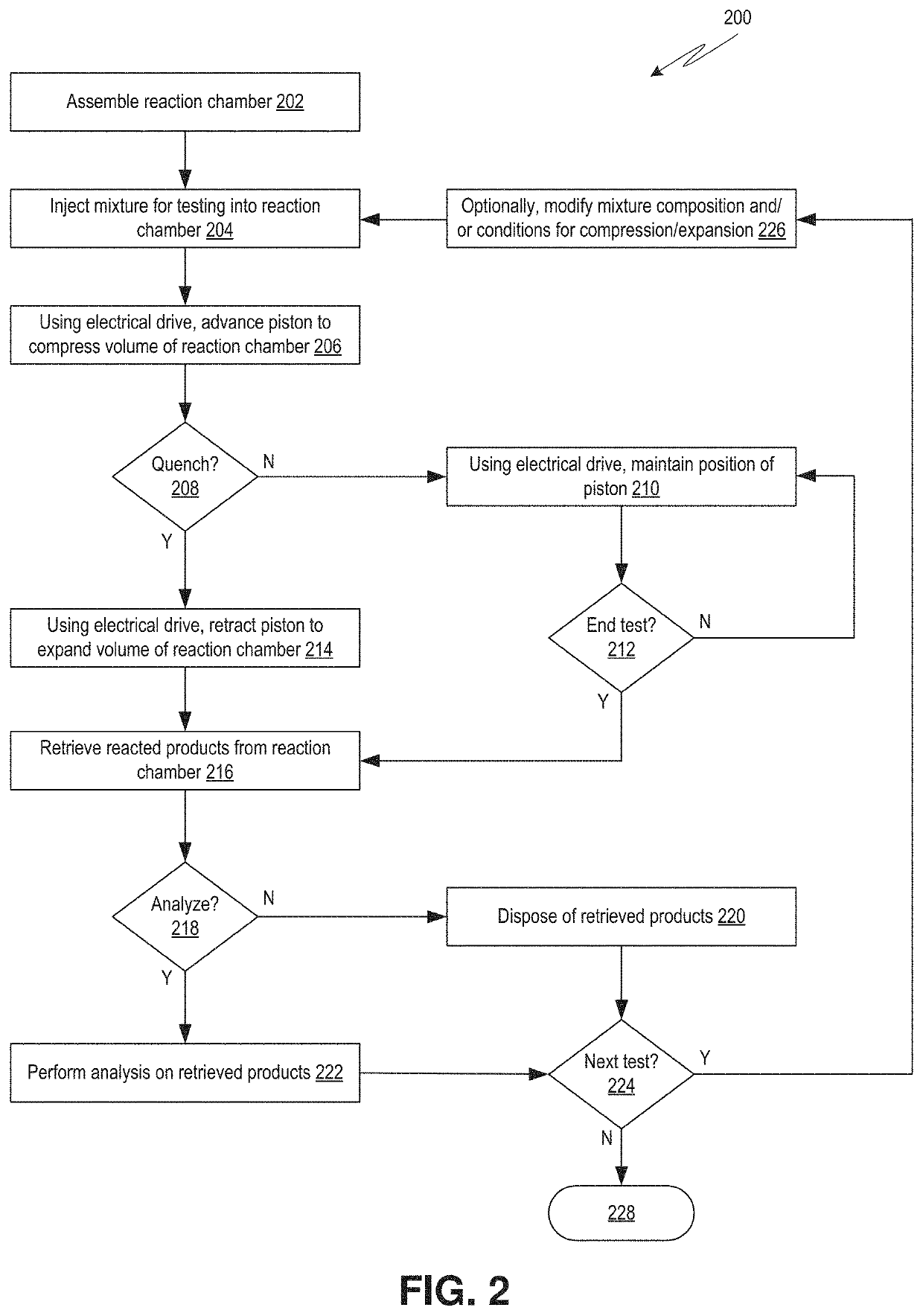Rapid compression machine with electrical drive and methods for use thereof
a compression machine and electric drive technology, applied in the direction of engine testing, structural/machine measurement, instruments, etc., can solve the problems that further analysis may not be necessary or desirable, and achieve the effect of increasing pressure and temperature in the reaction chamber and reducing the volume of the reaction chamber
- Summary
- Abstract
- Description
- Claims
- Application Information
AI Technical Summary
Benefits of technology
Problems solved by technology
Method used
Image
Examples
example 1
pression-Expansion Machine (RCEM)
[0089]FIGS. 3A-14D illustrates a fabricated RCEM 300 and components thereof that was used to investigate autoignition, ignition delay times, and induction-period stable intermediaries of n-Heptane. RCEM 300 has a linear actuator 310 (sold by Dunkermotoren GmbH, Bonndorf, Germany) that drives a thrust rod 332 (e.g., formed of stainless steel) with enclosed rare earth magnets in a linear fashion. The linear actuator 310 has therein a plurality of motor coils (e.g., stator coils) as well as position sensing electronics (e.g., integrated encoder). An electrical connector 340 on the linear actuator 310 is used to provide electrical power thereto as well as to provide communication between the linear actuator 310 and a control system (e.g., control system 114 in FIG. 1). The thrust rod 332 has a threaded end 338 that screws into a mounting hole 420 (see FIG. 4B) at a rear face 418 of piston 318 (e.g., formed of aluminum). The thrust rod 332 and piston 318 ...
example 2a
on of n-Heptane
[0100]Using a fabricated RCEM, the autoignition of n-Heptane was studied. A premixed test charge was prepared in a 12.41 L stainless steel vessel equipped with magnetic stirrers. The oxidizer was comprised of ultra-high purity argon and oxygen in a molar ratio of 1:3.76. The composition of the oxidizer was determined based on the fill pressure for each individual component, and an appropriate amount of liquid fuel (n-Heptane ≥99%) was weighed and injected into the mixing tank. This mixture was then introduced into the RCEM for the tests. The piston rapidly compresses the fixed mass of gas from an initial state (T0, P0) to a final compressed state (Pc, TC). A data acquisition device (NI PCIe-6351, X Series DAQ with 16 analog inputs, 24 digital inputs / outputs, and 2 analog outputs; sold by National Instruments, Austin, Tex.) was used to acquire pressure and encoder pulse data shown in FIGS. 15A and 15B.
[0101]As discussed above, the fabricated RCEM can operate with just ...
example 2b
elay Times
[0104]Using the fabricated RCEM, results were obtained for autoignition of n-Heptane at a compressed charge pressure (PC) of 5 bar and for compressed temperatures (TC) in a range of 600-750 K. Selected pressure traces for an equivalence ratio of ϕ=0.25 are shown in FIG. 17A, with the pressure trace corresponding to TC=600 labeled as 1704 and the pressure trace corresponding to TC=632K labeled as 1702. As shown in FIG. 17A, there is a clear two-stage ignition trend in the pressure-time records. FIG. 17B shows the first-stage delay 1706 and the overall ignition delay 1708 inferred from the pressure traces of FIG. 17A as a function of temperature. The overall ignition delay 1708 was seen to exhibit a negative temperature coefficient behavior while the first stage delay 1706 decreases monotonically with increasing temperature. FIGS. 17A-17B also show that the fabricated RCEM provided relatively-long ignition delay times of up to a quarter-second (250 ms). Such long delay times...
PUM
 Login to View More
Login to View More Abstract
Description
Claims
Application Information
 Login to View More
Login to View More - R&D
- Intellectual Property
- Life Sciences
- Materials
- Tech Scout
- Unparalleled Data Quality
- Higher Quality Content
- 60% Fewer Hallucinations
Browse by: Latest US Patents, China's latest patents, Technical Efficacy Thesaurus, Application Domain, Technology Topic, Popular Technical Reports.
© 2025 PatSnap. All rights reserved.Legal|Privacy policy|Modern Slavery Act Transparency Statement|Sitemap|About US| Contact US: help@patsnap.com



